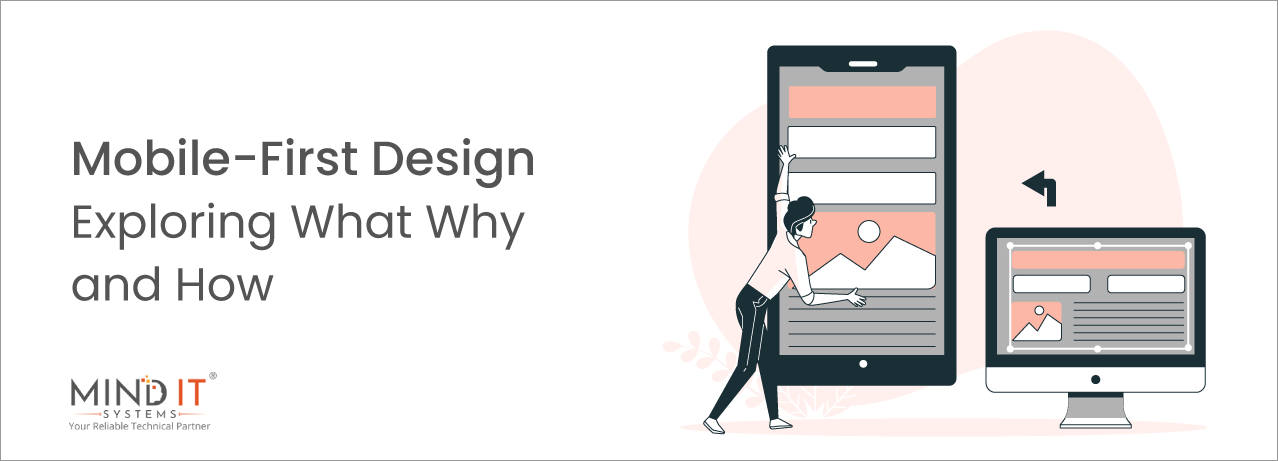
Mobile-First Design: Exploring What Why and How
Introduction
The world of web design has evolved quite a lot, and one concept that has taken center stage is the “Mobile-First Design.” With the digital realm becoming more focused on mobile devices, understanding the core principles of mobile-first design and uncovering this revolutionary approach’s “What, Why, and How” is crucial.
Our journey begins by diving deep into the Mobile First Design. This article unveils what it signifies- the difference between responsive and mobile-first, its immense significance, and sheds light on the best practices to implement. Buckle up as we explore the intricacies of mobile-first design and its profound impact on today’s digital landscape.
So, let’s get started!
What is Mobile-First Design?
Mobile First Design, also called progressive advancement, is a contemporary web design approach that places mobile devices at the forefront of the design and development process. This methodology primarily focuses on creating a user experience that caters to smartphones and other mobile devices. The rationale behind mobile-first design is grounded in the ever-expanding use of mobile devices to access the internet.
“Mobile-First Design is about recognizing that mobile devices are no longer just an option but primary means of online interaction.”
This approach encourages designers and developers to build a website with the smallest screens in mind, optimizing for limited-screen real grounds and touch-based interactions. It prioritizes simplicity, fast loading times, and intuitive navigation for mobile users. Mobile First Design doesn’t disregard desktop users but ensures the website works seamlessly across all devices.
Mobile First vs. Responsive Design
Mobile First Design stands in contrast to the traditional Responsive Design approach. In Responsive Design, websites are initially designed for desktop computers and then adapted to fit smaller screens. In comparison, mobile-first design begins with mobile devices as the primary target and then progressively enhances the design for larger screens. This shift in priorities recognizes the prevalence of mobile usage and seeks to provide an excellent mobile experience from the outset.
“Responsive Design used to be the norm, but Mobile-First Design is the way forward in today’s mobile-centric world.”
Why is the Mobile First Design Principle Significant?
The significance of the Mobile First Design principle lies in its alignment with current digital trends. Mobile devices, such as smartphones and tablets, have become the dominant means of accessing the internet. Google’s mobile-first indexing also underscores the importance of having a mobile-friendly website for search engine visibility.
Apart from these, the statistics below highlight “Why” mobile-first design is vital:
- An average person spends almost 3 hours and 15 minutes on their mobile phones.
- Nearly 58 times a day, an individual checks their phones.
- Daily, Millennials use their smartphones for more than 5.7 hours.
“Mobile-first design is not just a trend; it’s necessary to stay competitive and relevant in the digital age.”
By adhering to the Mobile First Design principle, businesses and website owners can:
- Enhance User Experience: Prioritizing mobile users ensures a smoother and more efficient experience for most website visitors.
- Improve SEO: Search engines favour mobile-friendly websites, leading to better search rankings and increased visibility.
- Increase Conversion Rates: A well-optimized mobile experience can increase conversion rates and more satisfied users.
How to Implement Mobile-First Design Rule – The Best Practices
Implementing Mobile First Design involves several best practices, including:
- Content Prioritization: Identify essential content and features for mobile users and place them prominently.
- Responsive Design: Create flexible layouts that adapt gracefully to various screen sizes.
- Performance Optimization: Optimize images and code to ensure fast loading times on mobile devices.
- Touch-Friendly Design: Design with touch gestures in mind, ensuring buttons and links are easily clickable.
- Progressive Enhancement: Gradually add complexity to larger screens, enhancing the desktop experience without compromising mobile usability.
“Mobile-First Design is not just about making things smaller; it’s about optimizing the entire user journey for mobile, which often results in a better desktop experience too.”
Wrapping Up
Mobile-first design has become a critical strategy for web designers and developers in a mobile-driven digital landscape. By starting with mobile devices in mind, prioritizing user experience and performance, and progressively enhancing the design for larger screens, websites can better cater to the needs of their audience and stay competitive in today’s online environment. Embracing mobile-first design is a wise choice and a strategic one for achieving online success.
Feel free to contact our experts for any query, assistance, or consultation.
Share this post
About the Author

Sujoy Roy
(Head – Digital Marketing)
From my teenage time, I had a quench to solve problems and loved leadership. Starting my career in relation management, ignited my passion for managing people. While managing I realized technology needs to be incorporated to keep pace with the changing world & do my work efficiently.

